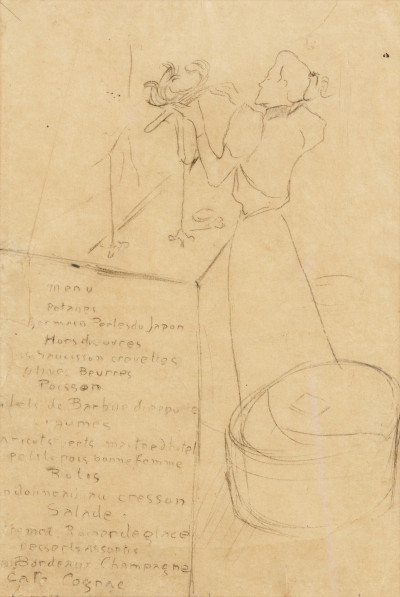La modiste chez Madame Renée Vert, or The Milliner at Madame Renée Vert, exists in several different forms from the career of Henri de Toulouse-Lautrec. The version in front of us here was produced using pencil on tracing paper in 1893.
A milliner is someone who makes women's hats and this role was far more common in the late 19th century than it is today. Clearly a number were to be found within Paris at that time because Henri de Toulouse-Lautrec features them in his work several times. He would develop this design for an advertisement or invitation, with a menu provided in text along the bottom left hand side within the final design. He would receive requests like this fairly often and enjoyed producing fairly brisk illustrations to celebrate a particular event. We do know that the particular event for this design was a June 1893 party for the Société des Artistes Indépendants (Society of Independent Artists), though the reason for why a hat maker was included, we are not sure. A more complete, coloured version of The Milliner, Renée Vert can be found in the permanent collection of the Art Institute of Chicago, who themselves own a good number of items from this artist's career.
The traced drawing in front of us here was given a pre-auction estimate of 24,000 - 32,000 EUR by Sotheby's in March, 2021 but ultimately went unsold. The auction event was based at their Paris office and was titled Purism and Beyond: A Modern Collection, featuring a good selection of French art. This particular item was listed as being 31 x 21 cm; 12¼ x 8¼ inches in size, but not much other information was provided on it other than its confirmed attribution to Toulouse-Lautrec, as well as its inclusion within his catalogue raisonne from the early 1970s. Its role as an invitational piece would have increased its value because most remember this artist best for his illustrations and posters which could be seen around Paris at this time and became a key part of his oeuvre. He impressed most when colours were added with his lithographic pieces, but the pencil drawings help us to see the raw talents of this important artist.
This artist played an important role in the development of illustration and graphic design, and continues to be studied by those looking to understand the origins of some of the principles still taught today. His work was highly contemporary, and his style was natural. It immediately helped to attract visitors to some of the things that he advertised, and his posters could be found across the city, promoting cabaret shows, novels and other items. He was much-in-demand during these period and struck an excellent balance between commercial success whilst still remaining true to his artistic wishes. He would sadly fall away due to poor health and unstable behaviour, but for many years was a key figure within the Parisien art world.




